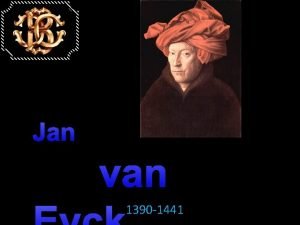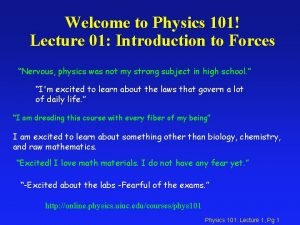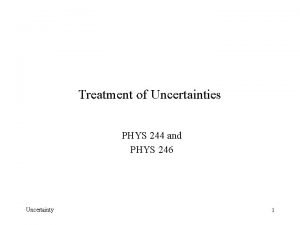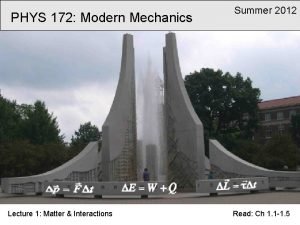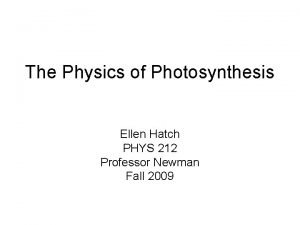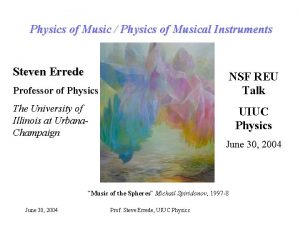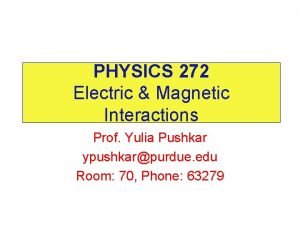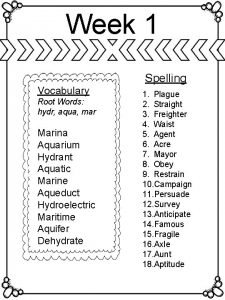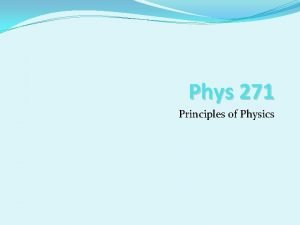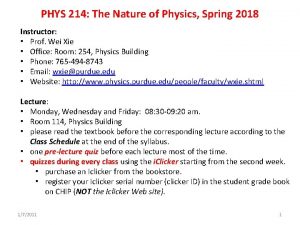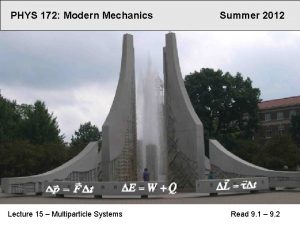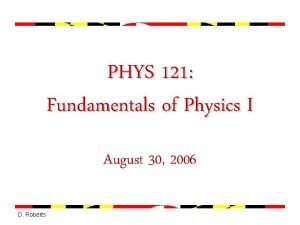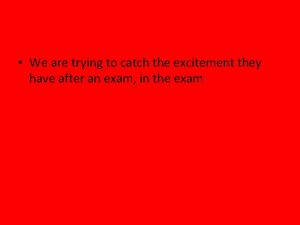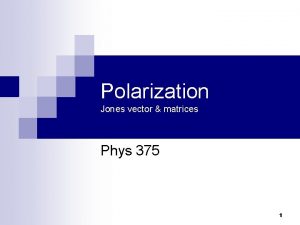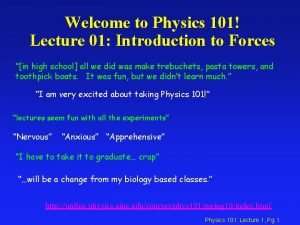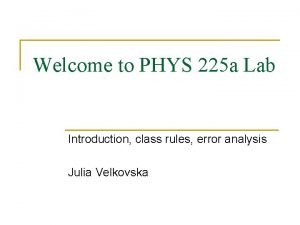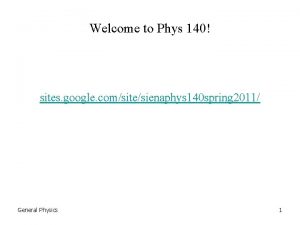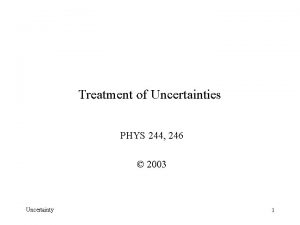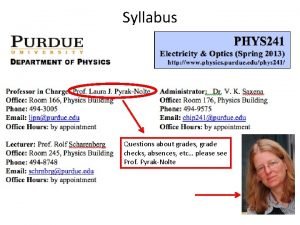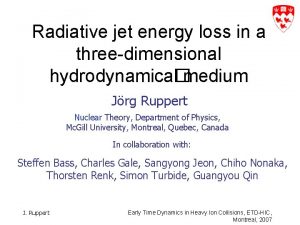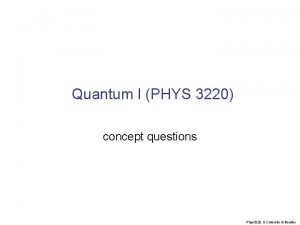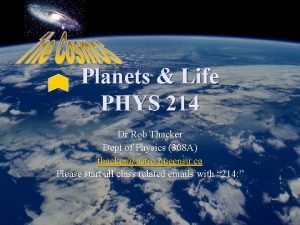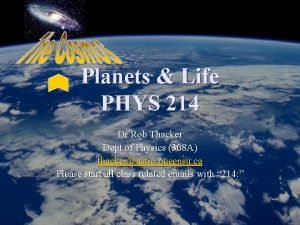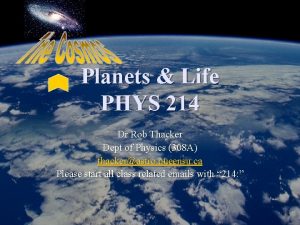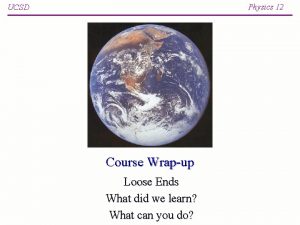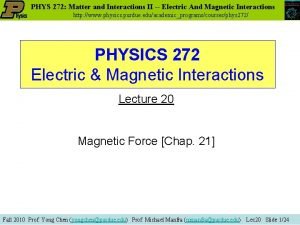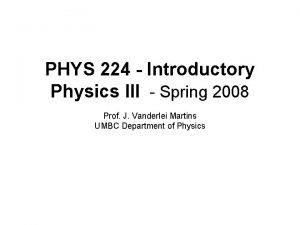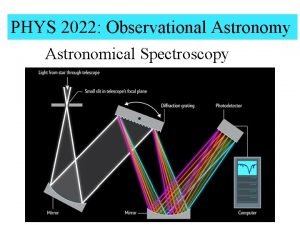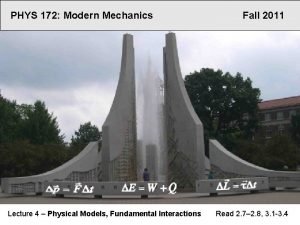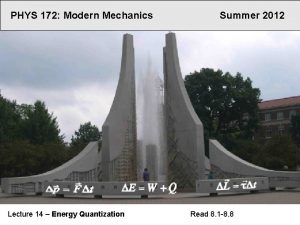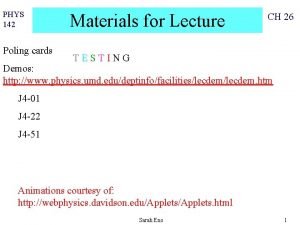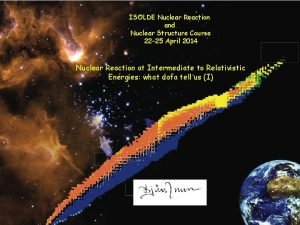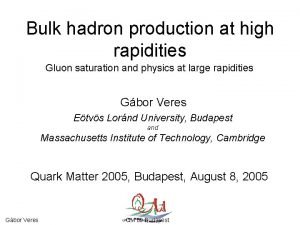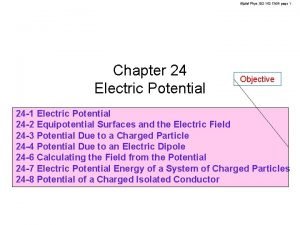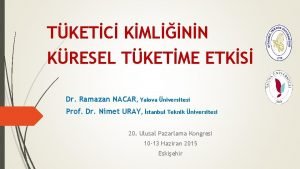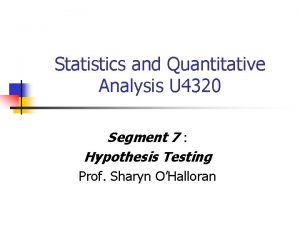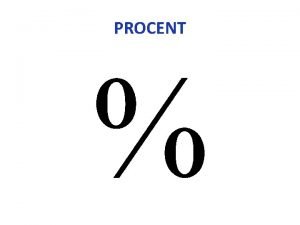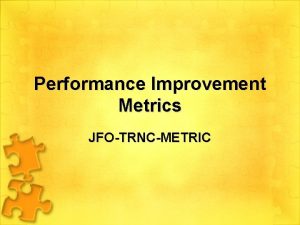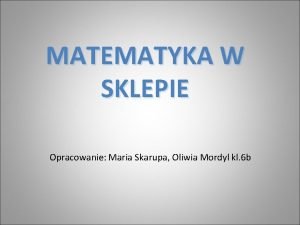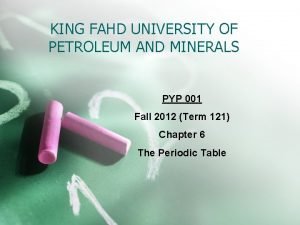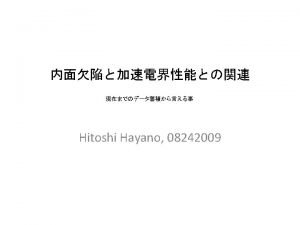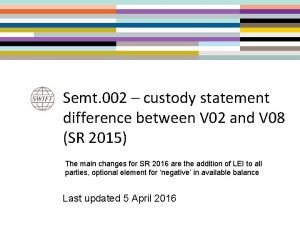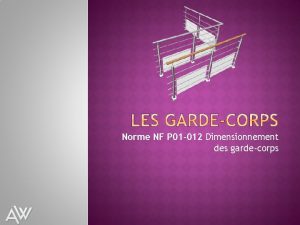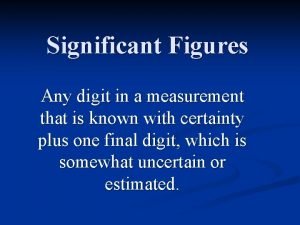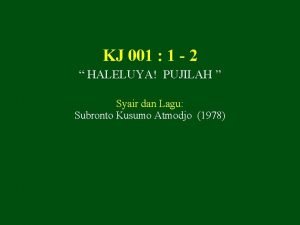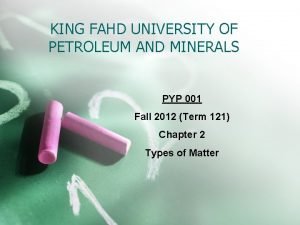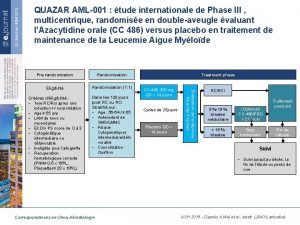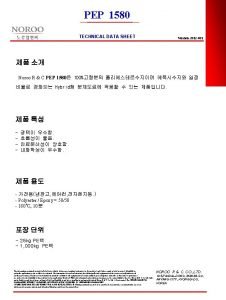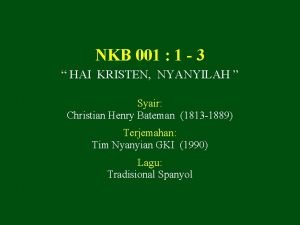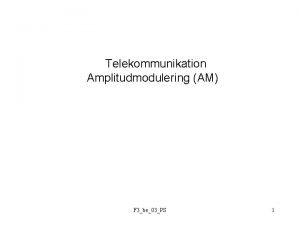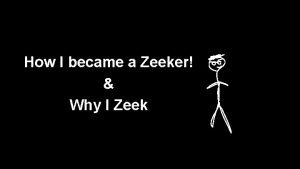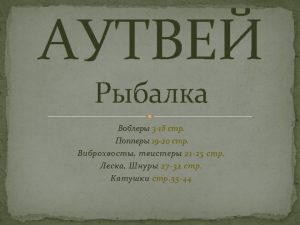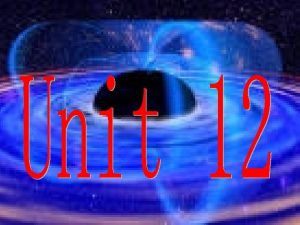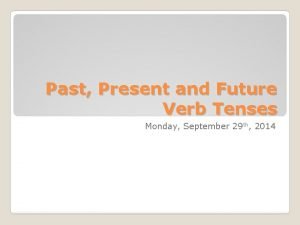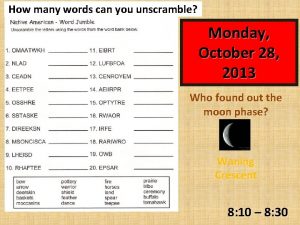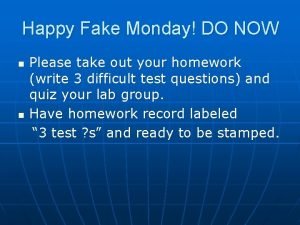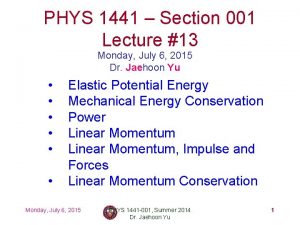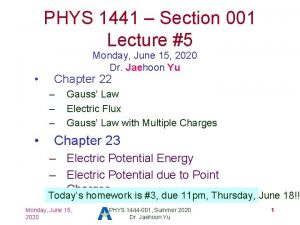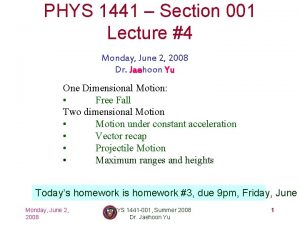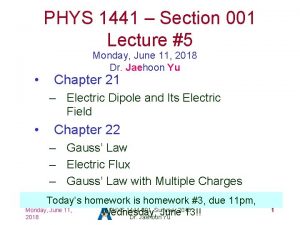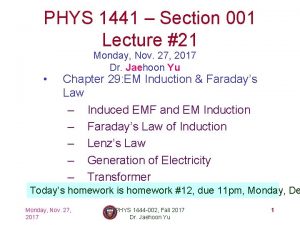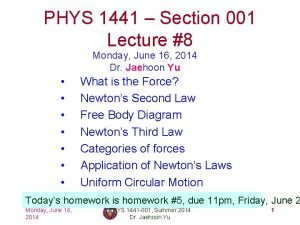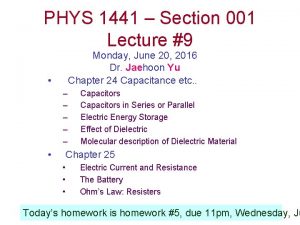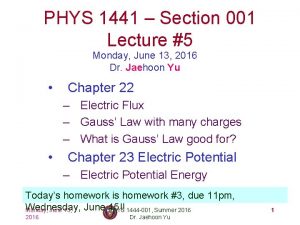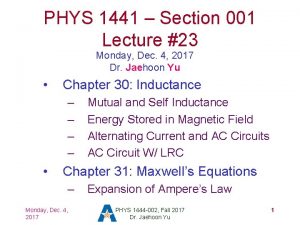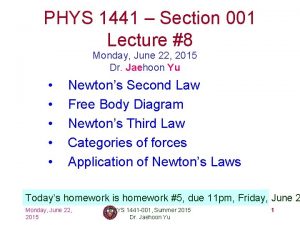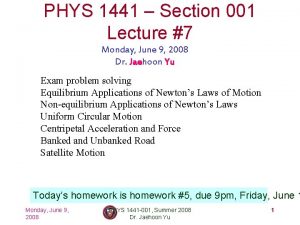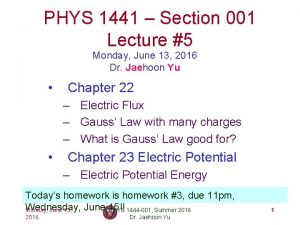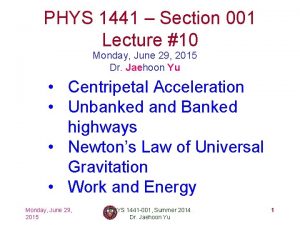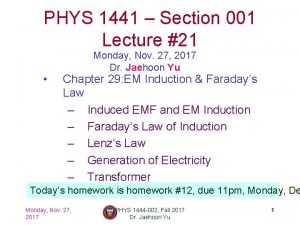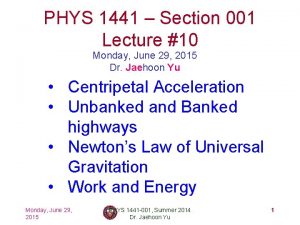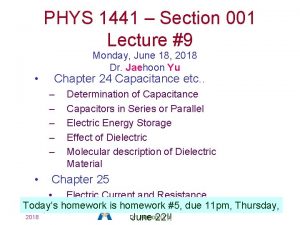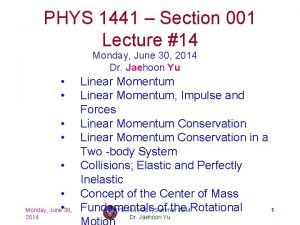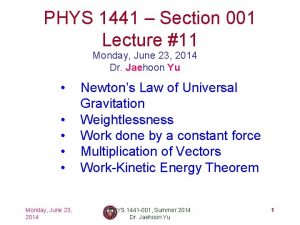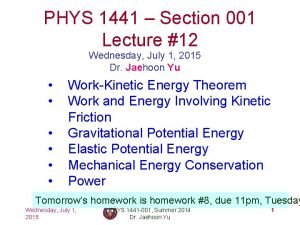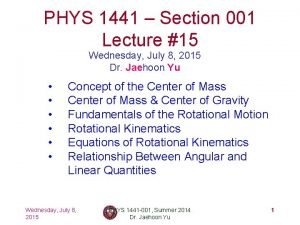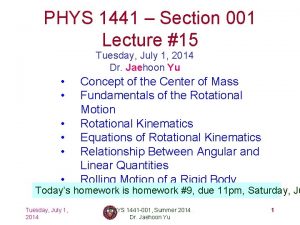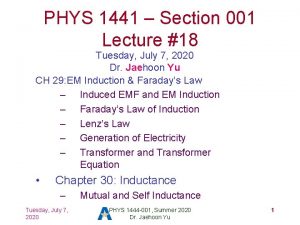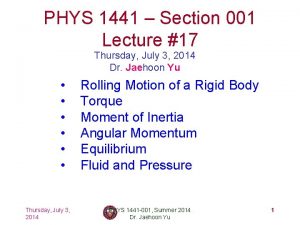PHYS 1441 Section 001 Lecture 16 Monday July











































































































































- Slides: 139

PHYS 1441 – Section 001 Lecture #16 • • Monday, July 2, 2018 Dr. Animesh Chatterjee Chapter 28: Sources of Magnetic Field – Magnetic Field Due to Straight Wire – Magnetic Materials – Hysteresis Chapter 29: EM Induction & Faraday’s Law – Induced EMF and EM Induction – Faraday’s Law of Induction – Lenz’s Law – Generation of Electricity Today’s homework is #9, due 11 pm, Thursday, July PHYS 1444 -001, Summer 2018 1 Thursday, July 5, 2018 Dr. Jaehoon Yu

PHYS 1441 – Section 001 Lecture #17 • • Tuesday, July 3, 2018 Dr. Animesh Chatterjee Chapter 29: EM Induction & Faraday’s Law – Transformer – Mutual and Self Inductance – Energy Stored in Magnetic Field – Alternating Current and AC Circuits Chapter 30: Inductance – Mutual and Self Inductance – Energy Stored in Magnetic Field Today’s homework is #10, due 11 pm, Saturday, Jul Thursday, July 5, 2018 PHYS 1444 -001, Summer 2018 Dr. Jaehoon Yu 2

PHYS 1441 – Section 001 Lecture #18 • Thursday, July 5, 2018 Dr. Animesh Chatterjee Chapter 30: Inductance – – – • Energy Stored in Magnetic Field Alternating Current and AC Circuits AC Circuit W/ LRC Chapter 31: Maxwell’s Equations – – Thursday, July 5, 2018 Expansion of Ampere’s Law Gauss’ Law for Magnetism Production of EM Waves Light as EM Waves PHYS 1444 -001, Summer 2018 Dr. Jaehoon Yu 3

• Quiz #4 Announcement – Beginning of the class Thursday, July 5 – Covers CH 28. 1 – what we finish Tuesday, July 3 – BYOF • Final Exam – In class 10: 30 – 12: 30, Monday, July 9 – Comprehensive Exam: Covers CH 21. 1 – what we finish Thursday, July 5 + Math refresher Appendices – BYOF • Reading Assignments: – Ch 29. 5, CH 29. 8, CH 30. 10 and CH 30. 11 • Be sure to bring your planetarium extra credit sheet Monday, PHYS July 1444 -001, 9 Summer 2018 Thursday, July 5, 2018 Dr. Jaehoon Yu 4

• Force Between Two Parallel Wires We have learned that a wire carrying the electric current produces magnetic field • Now what do you think will happen if we place two current carrying wires next to each other? – They will exert force onto each other. Repel or attract? – Depending on the direction of the currents • This was first pointed out by Ampére. • Let’s consider two long parallel conductors separated by a distance d, carrying currents I 1 and I 2. • At the location of the seconductor, the magnitude of the magnetic field produced by I 1 is Thursday, July 5, 2018 PHYS 1444 -001, Summer 2018 Dr. Jaehoon Yu 5

• Force Between Two Parallel Wires The force F by a magnetic field B on a 1 wire of length l, carrying the current I 2 when the field and the current are perpendicular to each other is: – So the force per unit length is – This force is only due to the magnetic field generated by the wire carrying the current I 1 • There is the force exerted on the wire carrying the current I 1 by the wire carrying current I 2 of the same magnitude but in opposite direction • So the force per unit length is • Thursday, about the direction of the force? July 5, PHYS 1444 -001, Summer 2018 If. How the currents are in the same direction, the attractive force. 2018 Dr. Jaehoon Yu 6 If opposite, re

Example 28 – 5 Suspending a wire with current. A horizontal wire carries a current I 1=80 A DC. A second parallel wire 20 cm below it must carry how much current I 2 so that it doesn’t fall due to the gravity? The lower has a mass of 0. 12 g per meter length. is the gravitational Down to the center of the Whichofdirection Earth force? This force must be balanced by the magnetic force exerted on the wire by the first wire. Solving for I 2 Thursday, July 5, 2018 PHYS 1444 -001, Summer 2018 Dr. Jaehoon Yu 7

Operational Definition of Ampere and Coulomb • The permeability of free space is defined to be exactly • The unit of current, ampere, is defined using the definition of the force between two wires each carrying 1 A of current and separated by 1 m – So 1 A is defined as: the current flowing each of two long parallel conductors 1 m apart, which results in a force of exactly 2 x 10 -7 N/m. • Coulomb is then defined as exactly 1 C=1 A s. Thursday, Julyit 5, this way PHYS 1444 -001, Summer 2018 • We do since the electric current is 2018 Dr. Jaehoon Yu 8

Ampére’s Law • What is the relationship between the magnetic field strength and the current? – Does this work in all cases? • Nope! • OK, then when? • Only valid for a long straight wire • Then what would be the more generalized relationship between the current and the magnetic field for any shapes of the wire? – French scientist André Marie Ampére proposed such a relationship soon after Oersted’s discovery Thursday, July 5, PHYS 1444 -001, Summer 2018 9 2018 Dr. Jaehoon Yu

Ampére’s Law • Let’s consider an arbitrary closed path around the current as shown in the figure. – Let’s split this path in small segments – The all the products of the length of eachsum of Δloflong. each segment and the component of B parallel to that segment is equal to μ 0 times the net current Iencl that passes through the surface enclosed by the path – – In the limit Δl 0, this relation becomes Looks very similar to a Ampére’s law in the electricity. Law – Which law is it? Thursday, July 5, 2018 PHYS 1444 -001, Summer 2018 Dr. Jaehoon Yu Gauss’ Law 10

Verification of Ampére’s Law • Let’s find the magnitude of B at a distance r away from a long straight wire w/ current I – This is a verification of Ampere’s Law – We can apply Ampere’s law to a circular path of radius r. Solving for B – We just verified that Ampere’s law works in a simple case – Experiments verified that it works for other Thursday, July 5, too PHYS 1444 -001, Summer 2018 11 cases 2018 Dr. Jaehoon Yu

Verification of Ampére’s Law • Since Ampere’s law is valid in general, B in Ampere’s law is not just due to the current Iencl. • B is the field at each point in space along the chosen path due to all sources – Including the current I enclosed by the path but also due to any other sources – How do you obtain B in the figure at any point? • Vector sum of the field by the two currents – The result of the closed path integral in Ampere’s law for green dashed path is still μ 0 I 1. Why? – While B in each point along the path varies, the integral over the closed path still comes out the same whethere is the second wire or not. Thursday, July 5, 2018 PHYS 1444 -001, Summer 2018 Dr. Jaehoon Yu 12

Example 28 – 6 Field inside and outside a wire. A long straight cylindrical wire conductor of radius R carries current I of uniform density in the conductor. Determine the magnetic field at (a) points outside the conductor (r>R) and (b) points inside the conductor (r<R). Assume that r, the radial distance from the axis, is much less than the length of the wire. (c) If Since the wire long, what straight symmetric, the field should R=2. 0 mm and is I=60 A, is Band at r=1. 0 mm, be the same any point the same distance from the center of r=2. 0 mm andatr=3. 0 mm? the wire. Since B must be tangential to circles around the wire, let’s choose a circular path of the closed-path integral outside the wire (r>R). Ampere’s What is Iencl? So using law Solving for B Thursday, July 5, 2018 PHYS 1444 -001, Summer 2018 Dr. Jaehoon Yu 13

Example 28 – 6 cont’d For r<R, the current inside the closed path is less than I. How much is it? So using Ampere’s law Solving for B What does this mean? The field is 0 at r=0 and increases linearly as a function of the distance from the center of the wire up to r=R then decreases as 1/r beyond the radius of the conductor. Thursday, July 5, 2018 PHYS 1444 -001, Summer 2018 Dr. Jaehoon Yu 14

Example 28 – 7 Coaxial cable. A coaxial cable is a single wire surrounded by a cylindrical metallic braid, as shown in the figure. The two conductors are separated by an insulator. The central wire carries current to the other end of the cable, and the outer braid carries the return current and is usually considered ground. Describe the magnetic field (a) in the space between the conductors and (b) outside the cable. the conductors (a) The magnetic field between is the same as the long, straight wire case since the current in the outer conductor does not impact the enclosed (b) Outside the cable, current. we can draw a similar circular path, since we expect the field to have a circular symmetry. What is the sum of the total current inside the closed path? So there is no magnetic field outside a coaxial cable. In other words, the coaxial cable self-shields. The outer conductor also shields against an external electric field. Thursday, signal July 5, PHYS 1444 -001, Summer 2018 15 Cleaner and less noise. 2018 Dr. Jaehoon Yu

Solenoid and Its Magnetic Field • What is a solenoid? – A long coil of wire consisting of many loops – If the space between loops are wide • The field near the wires are nearly circular • Between any two wires, the fields due to each loop cancel • Toward the center of the solenoid, Solenoid the fields add up Axis to give a field that can be fairly large and uniform – For a long, densely packed loops • The field is nearly uniform and parallel to the solenoid axes within the entire cross section • The field outside the solenoid is very small compared to the field inside, except the ends – The same number of field lines spread out to an open Thursday, Julyspace 5, PHYS 1444 -001, Summer 2018 Dr. Jaehoon Yu 16

Solenoid Magnetic Field • Now let’s use Ampere’s law to determine the magnetic field inside a very long, densely packed solenoid • Let’s choose the path abcd, far away from the ends – We can consider four segments of the loop for integral – – The field outside the solenoid is negligible. So the Thursday, July 5, PHYS 1444 -001, Summer 2018 17 integral on a b is 0. 2018 Dr. Jaehoon Yu

Solenoid Magnetic Field – So the sum becomes: – If the current I flows in the wire of the solenoid, the total current enclosed by the closed path is NI • Where N is the number of loops (or turns of the coil) enclosed – Thus Ampere’s law gives us – If we let n=N/l be the number of loops per unit length, the magnitude of the magnetic field within the solenoid becomes – • B depends on the number of loops per unit length, n, and the current I Thursday, July 5, – Does 2018 PHYS 1444 -001, Summer 2018 18 not depend on the position within the solenoid but Dr. Jaehoon Yu

Example 28 – 10 Toroid. Use Ampere’s law to determine the magnetic field (a) inside and (b) outside a toroid, which is like a solenoid bent into the shape a you circle. (a) Howofdo think the magnetic field lines inside the toroid Since look? it is a bent solenoid, it should be a circle concentric with toroid. If wethe choose path of integration one of these field lines of radius r inside the toroid, path 1, to use the symmetry of the situation, making B the same at all points on the path, we obtain from Ampere’s law Solving for B So the magnetic field inside a toroid is not uniform. It is larger on the inner edge. However, the field will be uniform if the radius is large and the toroid is thin. The filed in this case is B = the μ 0 n. I. (b) Outside solenoid, the field is 0 since the net enclosed Thursday, is July 0. 5, PHYS 1444 -001, Summer 2018 19 current 2018 Dr. Jaehoon Yu

Biot-Savart Law • Ampere’s law is useful in determining magnetic field utilizing symmetry • But sometimes it is useful to have another method of using infinitesimal current segments for B field – Jean Baptiste Biot and Feilx Savart developed a law that a current I flowing in any path can be considered as many infinitesimal current elements – The infinitesimal magnetic field d. B caused by the infinitesimal length dl that carries current I is Biot-Savart – Law • r is the displacement vector from the element dl to the point P Thursday, Julyin 5, Biot-Savart PHYSlaw 1444 -001, Summer 2018 by the current, 20 B field is only that 2018 • Biot-Savart law is the magnetic Dr. Jaehoon Yu equivalent to Coulomb’s law nothing else.

Example 28 – 11 B due to current I in a straight wire. For the field near a long straight wire carrying a current I, show that the Biot-Savarat law gives the same result as the simple long straight wire, is B=μ What the direction of the field B at Going into the 0 I/2πR. point All d. BP? at point P has the same direction page. based on right-hand rule. The magnitude of B using Biot-Savart law is Where dy=dl and r 2=R 2+y 2 and since we obtain Integral becomes Thursday, July 5, 2018 PHYS 1444 -001, Summer 2018 The same as the simple, long straight wire!! It Dr. Jaehoon Yu 21

• Magnetic Materials Iron is a material that can turn into a strong magnet Ferromagnetism – This kind of material is called ferromagnetic material • In microscopic sense, ferromagnetic materials consist of many tiny regions called domains – Domains are like little magnets usually smaller than 1 mm in length or width • What do you think the alignment of domains are like when they are not magnetized? – Randomly arranged • What if they are magnetized? – The size of the domains aligned with the external magnetic field direction grows while those of the domains not aligned reduce – This gives magnetization to the material • How do we demagnetize a bar magnet? – Hit the magnet hard. PHYS or heat it over the 2018 Thursday, July 5, 1444 -001, Summer 2018 Curie temperature Dr. Jaehoon Yu 22

• • B in Magnetic Materials What is the magnetic field inside a solenoid? – Magnetic field in a long solenoid is directly proportional to the current. – This is valid only if air is inside the coil • What do you think will happen to B if we have something other than the air inside the solenoid? – It will be increased dramatically, when the current flows • Especially if a ferromagnetic material such as an iron is put inside, the field could increase by several orders of magnitude • Why? – Since the domains in the iron aligns permanently by the external field. – The resulting magnetic field is the sum of that due to current and due to the iron Thursday, July 5, 2018 PHYS 1444 -001, Summer 2018 Dr. Jaehoon Yu 23

B in Magnetic Materials • It is sometimes convenient to write the total field as the sum of two terms • – B 0 is the field due only to the current in the wire, namely the external field • The field that would be present without a ferromagnetic material – BM is the additional field due to the ferromagnetic material itself; often BM>>B 0 • The total field in this case can be written by replacing μ 0 with another proportionality constant μ, the magnetic permeability of the material – μ is a property PHYS of a 1444 -001, magnetic material Summer 2018 Thursday, July 5, 2018 Dr. Jaehoon Yu 24

• Hysteresis Iron C ore To What is a toroid? r – A solenoid bent into a shape oid • Toroid can be used for magnetic field measurement – Why? – Since it does not leak magnetic field outside of itself, it fully contains all the magnetic field created within it. • Consider an un-magnetized iron core toroid, without any current flowing in the wire – What do you think will happen if the current slowly increases? – B 0 increases linearly with the current. – And B increases also but follows the curved line shown in the graph – As B 0 increases, the domains become more aligned until Thursday, July 5, PHYS 1444 -001, Summer 2018 25 nearly all are aligned (point b on the graph) 2018 Dr. Jaehoon Yu

Hysteresis • What do you think will happen to B if the external field B 0 is reduced to 0 by decreasing the current in the coil? – Of course it goes to 0!! – Wrong! They do not go to 0. Why not? – The domains do not completely return to random alignment state • Now if the current direction is reversed, the external magnetic field direction is reversed, causing the total field B pass 0, and the direction reverses to the opposite side – If the current is reversed again, the total field B will increase but never goes through the origin • This kind of curve whose path does not retrace themselves and does not Thursday, July 5, the origin PHYS 1444 -001, Summer 2018 go through is called the 2018 Dr. Jaehoon Yu 26

Magnetically Soft Material • In a hysteresis cycle, much energy is transformed to thermal energy. Why? – Due to the microscopic friction between domains as they change directions to align with the external field • The energy dissipated in the hysteresis cycle is proportional to the area of the hysteresis loop • Ferromagnetic material with large hysteresis area is called magnetically hard while the small ones are called soft – Which one do you think are preferred in electromagnets or transformers? • Soft. Why? • Since the energy loss is small and much easier to switch off the field • Then how do we demagnetize a ferromagnetic material? Thursday, July 5, PHYS 1444 -001, Summer 2018 Dr. Jaehoon Yu – 2018 Keep repeating the Hysteresis loop, reducing the 27

Induced EMF • It has been discovered by Oersted and company in early 19 th century that – Magnetic field can be produced by the electric current – Magnetic field can exert force on the electric charge • So if you were scientists at that time, what would you wonder? – Yes, you are absolutely right! You would wonder if the magnetic field can create the electric current. – An American scientist Joseph Henry and an English scientist Michael Faraday independently found that it was possible • Though, Faraday was given the credit since he published his work before Henry did – He also did a lot of detailed studies on magnetic induction Thursday, July 5, 2018 PHYS 1444 -001, Summer 2018 Dr. Jaehoon Yu 28

Electromagnetic Induction • Faraday used an apparatus below to show that magnetic field can induce current • Despite his hope he did not see steady current induced on the other side when the switch is thrown • But he did see that the needle on the Galvanometer turns strongly when the switch is initially thrown and is opened – When the magnetic field through coil Y changes, a current flows as if there were a source of emf July 5, PHYS 1444 -001, Summer 2018 • Thursday, Thus he concluded that an induced emf is 2018 Dr. Jaehoon Yu 29

Electromagnetic Induction • Further studies on electromagnetic induction taught – If a magnet is moved quickly into a coil of wire, a current is induced in the wire. – If a magnet is removed from the coil, a current is induced in the wire in the opposite direction – By the same token, the current can also be induced if the magnet stays put but the coil moves toward or away from the magnet – Current is also induced if the coil rotates. • In other words, it does not matter whether the magnet or the coil moves. It is the relative motion that counts. Thursday, July 5, 2018 PHYS 1444 -001, Summer 2018 Dr. Jaehoon Yu 30

Magnetic Flux • So what do you think is the induced emf proportional to? – The rate of changes of the magnetic field? • the higher the changes the higher the induction – Not really, it rather depends on the rate of change of the magnetic flux, flux ΦB. – Magnetic flux is defined as (just like the electric flux) – • θ is the angle between B and the area vector A whose direction is perpendicular to the face of the loop based on the right-hand rule – What kind of quantity is the magnetic flux? • Scalar. Unit? • or weber July 5, PHYS 1444 -001, Summer 2018 • Thursday, If the area of the loop is not simple or B is not 2018 Dr. Jaehoon Yu 31

Faraday’s Law of Induction • In terms of magnetic flux, we can formulate Faraday’s findings – The emf induced in a circuit is equal to the rate of change of magnetic flux through the circuit Faraday’s Law of Induction • If the circuit contains N closely wrapped loops, the total induced emf is the sum of emf induced in each loop – Why negative? • Has got a lot to do with the direction of induced emf… Thursday, July 5, 2018 PHYS 1444 -001, Summer 2018 Dr. Jaehoon Yu 32

Lenz’s Law • It is experimentally found that – An induced emf gives rise to a current whose magnetic field opposes the original change in flux This is known as Lenz’s Law – In other words, an induced emf is always in a direction that opposes the original change in flux that caused it. – We can use Lenz’s law to explain the following cases in the figures • When the magnet is moving into the coil – Since the external flux increases, the field inside the coil takes the opposite direction to minimize the change and causes the current to flow clockwise • When the magnet is moving out – Since the external flux decreases, the field inside the coil takes the opposite direction to compensate the loss, causing the current to flow counter-clockwise • Which law is Lenz’s law result of? – Energy conservation. Why? Thursday, July 5, PHYS 1444 -001, Summer 2018 Dr. Jaehoon Yu 33

Induced EMF • It has been discovered by Oersted and company in early 19 th century that – Magnetic field can be produced by the electric current – Magnetic field can exert force on the electric charge • So if you were scientists at that time, what would you wonder? – Yes, you are absolutely right! You would wonder if the magnetic field can create the electric current. – An American scientist Joseph Henry and an English scientist Michael Faraday independently found that it was possible • Though, Faraday was given the credit since he published his work before Henry did – He also did a lot of detailed studies on magnetic induction Thursday, July 5, 2018 PHYS 1444 -001, Summer 2018 Dr. Jaehoon Yu 34

Electromagnetic Induction • Faraday used an apparatus below to show that magnetic field can induce current • Despite his hope he did not see steady current induced on the other side when the switch is thrown • But he did see that the needle on the Galvanometer turns strongly when the switch is initially thrown and is opened – When the magnetic field through coil Y changes, a current flows as if there were a source of emf July 5, PHYS 1444 -001, Summer 2018 • Thursday, Thus he concluded that an induced emf is 2018 Dr. Jaehoon Yu 35

Electromagnetic Induction • Further studies on electromagnetic induction taught – If a magnet is moved quickly into a coil of wire, a current is induced in the wire. – If a magnet is removed from the coil, a current is induced in the wire in the opposite direction – By the same token, the current can also be induced if the magnet stays put but the coil moves toward or away from the magnet – Current is also induced if the coil rotates. • In other words, it does not matter whether the magnet or the coil moves. It is the relative motion that counts. Thursday, July 5, 2018 PHYS 1444 -001, Summer 2018 Dr. Jaehoon Yu 36

Magnetic Flux • So what do you think is the induced emf proportional to? – The rate of changes of the magnetic field? • the higher the changes the higher the induction – Not really, it rather depends on the rate of change of the magnetic flux, flux ΦB. – Magnetic flux is defined as (just like the electric flux) – • θ is the angle between B and the area vector A whose direction is perpendicular to the face of the loop based on the right-hand rule – What kind of quantity is the magnetic flux? • Scalar. Unit? • or weber July 5, PHYS 1444 -001, Summer 2018 • Thursday, If the area of the loop is not simple or B is not 2018 Dr. Jaehoon Yu 37

Faraday’s Law of Induction • In terms of magnetic flux, we can formulate Faraday’s findings – The emf induced in a circuit is equal to the rate of change of magnetic flux through the circuit Faraday’s Law of Induction • If the circuit contains N closely wrapped loops, the total induced emf is the sum of emf induced in each loop – Why negative? • Has got a lot to do with the direction of induced emf… Thursday, July 5, 2018 PHYS 1444 -001, Summer 2018 Dr. Jaehoon Yu 38

Lenz’s Law • It is experimentally found that – An induced emf gives rise to the current whose magnetic field opposes the original change in flux This is known as Lenz’s Law – In other words, an induced emf is always in the direction that opposes the original change in flux that caused it. – We can the usemagnet Lenz’sis law to explain the following cases in • When moving into the coil the figures – Since the external flux increases, the field inside the coil takes the opposite direction to minimize the change and causes the current to flow clockwise • When the magnet is moving out – Since the external flux decreases, the field inside the coil takes the opposite direction to compensate the loss, causing the current to flow counter-clockwise • Which law is Lenz’s law result of? – Energy conservation. Why? Thursday, July 5, 2018 PHYS 1444 -001, Summer 2018 Dr. Jaehoon Yu 39

Induction of EMF • How can we induce emf? • Let’s look at the formula for the magnetic flux • • What do you see? What are things that can change with time to result in change of magnetic flux? – Magnetic field – The area of the loop – The angle θ between the field and the area Thursday, July 5, PHYS 1444 -001, Summer 2018 vector 2018 Dr. Jaehoon Yu 40

Example 29 – 5 Pulling a coil from a magnetic field. A square coil of wire with side 5. 00 cm contains 100 loops and is positioned perpendicular to a uniform 0. 600 -T magnetic field. It is quickly and uniformly pulled from the field (moving perpendicular to B) to a region where B drops abruptly to zero. At t=0, the right edge of the coil is at the edge of the It takes 0. 100 s wholethe coil, (b) the emf and region. Find (a) field. the rate of change in for fluxthe through to theinduced, field-freeand (c) how much energy is dissipated in the coil if its thereach current resistance is 100Ω. (d) what was the average force required? What should be computed first? The flux at t=0 is The change of flux is The initial flux at t=0. Thus the rate of change of the flux is Thursday, July 5, 2018 PHYS 1444 -001, Summer 2018 Dr. Jaehoon Yu 41

Example 29 – 5, cnt’d Thus the total emf induced in this period is The induced current in this period is Which direction would the induced current The totalflow? energy dissipated is Force for each coil is Thursday, July 5, 2018 Clockwis e Force for N coil is PHYS 1444 -001, Summer 2018 Dr. Jaehoon Yu 42

• EMF Induced on a Moving Conductor Another way of inducing emf is using a U shaped conductor with a movable rod resting on it. • As the rod moves at a speed v, it travels in time dt, changing area ofemf thefor this loop • vdt Using Faraday’s law, thethe induced loop is by d. A=lvdt. – This equation is valid as long as B, l and v are perpendicular to each other. What do we do if not? • Use the scalar product of vector quantities • An emf induced on a conductor moving in a magnetic a motional emf Thursday, July 5, field is called PHYS 1444 -001, Summer 2018 Dr. Jaehoon Yu 43

Electric Generators • What does a generator do? – Transforms mechanical energy into the electrical energy – What does this look like? • An inverse of an electric motor which transforms electrical energy to mechanical energy • – Whose law does the generator based An electric generator is also called a dynamo on? – Faraday’s law of induction Thursday, July 5, 2018 PHYS 1444 -001, Summer 2018 Dr. Jaehoon Yu 44

• How does an Electric Generator work? An electric generator consists of – Many coils of wires wound on an armature that can rotate by mechanical means in a magnetic field • An emf is induced in the rotating coil • Electric current is the output of a • generator Which direction does the output current flow when the armature rotates counterclockwise? – The conventional current flows outward on wire A toward the brush – After half the revolution the wire A will be where the wire C is and the current flow on A is reversed • Thus produced is alternating its Thursday, the July 5, current PHYS 1444 -001, Summer 2018 Dr. Jaehoon Yu 45

• How does an Electric Generator work? Let’s assume the loop is rotating in a uniform B field w/ a constant angular velocity ω. The induced emf is • • What is the variable that changes above? – The angle θ. What is dθ /dt? • The angular speed ω. – – – So θ =θ 0+ωt If we choose θ 0=0, we obtain If the coil contains N loops: What is the shape of the output? • Sinusoidal w/ the amplitude ε 0=NBAω • USA frequency is 60 Hz. Europe is at 50 Hz – Most the U. S. power is generated at steam plants Thursday, July 5, 2018 PHYS 1444 -001, Summer 2018 Dr. Jaehoon Yu 46

Example 29 – 9 An AC generator. The armature of a 60 -Hz AC generator rotates in a 0. 15 -T magnetic field. If the area of the coil is 2. 0 x 10 -2 m 2, how many loops must the coil contain if the peak output is to be ε 0=170 V? The maximum emf of a generator is Solving for N Sinc e Thursday, July 5, 2018 We obtain PHYS 1444 -001, Summer 2018 Dr. Jaehoon Yu 47

US Electricity Sources Thursday, July 5, 2018 PHYS 1444 -001, Summer 2018 Dr. Jaehoon Yu 48

US Electric E Consumption by Users US Energy Information Administration http: //www. eia. gov/electricity/ Thursday, July 5, 2018 PHYS 1444 -001, Summer 2018 Dr. Jaehoon Yu 49

The World Energy Consumption • In 2013, total worldwide energy consumption was 567 EJ (567× 1018 J=157 PWh) expected >1000 EJ by 2050 – Equivalent to an average energy consumption rate of 18 terawatts (1. 8× 1013 W) – US uses 39. 1 PWh (1. 38 k. Wh/person, as of 2014) • The potential for renewable energy – solar energy 1600 EJ (444, 000 TWh) – wind power 600 EJ (167, 000 TWh) – geothermal energy 500 EJ (139, 000 TWh), – biomass 250 EJ (70, 000 TWh) – hydropower 50 EJ (14, 000 TWh) an – ocean energy 1 EJ (280 TWh) Thursday, July 5, PHYS 1444 -001, Summer 2018 – Read this paper if you want Yu to learn more 2018 Dr. Jaehoon 50

A DC Generator • A DC generator is almost the same as an AC generator except the slip rings are replaced by split-ring commutators Smooth output using many windings • Output can be smoothed out by placing a capacitor in parallel to the output – More commonly done using many armature windings Thursday, July 5, 2018 PHYS 1444 -001, Summer 2018 Dr. Jaehoon Yu 51

Transformer • What is a transformer? – A device for increasing or decreasing an AC voltage – A few examples? • TV sets to provide the high voltage to picture tubes, portable electronic device converters, transformers on the pole, etc • A transformer consists of two coils of wires known as the primary and the secondary – The two coils can be interwoven or linked by a • Transformers are laminated soft iron core to reduce losses due designed so that all to Eddy current magnetic flux produced by the primary coil pass Thursday, July 5, PHYS 1444 -001, Summer 2018 through the secondary 2018 Dr. Jaehoon Yu 52

How does a transformer work? • When an AC voltage is applied to the primary, the changing B it produces will induce voltage of the same frequency in the secondary wire • So how would we make the voltage different? – By varying the number of loops in each coil – From Faraday’s law, the induced emf in the secondary is – – The input primary voltage is Transform – Thursday, July 5, PHYS er 1444 -001, Summer 2018 Dr. Jaehoon Yu Equation 53

Transformer Equation • The transformer equation does not work for DC current – Since there is no change of magnetic flux!! • If NS>NP, the output voltage is greater than the input so it is called a step-up transformer while NS<NP is called step-down transformer • Now, it looks like energy conservation is violated since we can get more emf from smaller ones, right? – Wrong! Energy is always conserved! The output current for a step-up transformer will be lower than the input, while is larger for a than step-down x – A well designed transformer canit be more -former than the input. 99% Thursday, July efficient 5, PHYS 1444 -001, Summer 2018 54 2018 Dr. Jaehoon Yu

Example for A Transformer Portable radio transformer. A transformer for home use of a portable radio reduces 120 -V AC to 9. 0 V AC. The secondary contains 30 turns, and the radio draws 400 m. A. Calculate (a) the number of turns in the primary (b) the current in the primary and (c) the power transformed. (a) What kind of a transformer A step-down xis this? former Sinc We e obtain We (b) Also from the obtain transformer equation (c) Thus the power transformed is How about the input The same assuming 100% Thursday, July 5, PHYS 1444 -001, Summer 2018 power? efficiency. 2018 Dr. Jaehoon Yu 55

Example 29 – 13: Power Transmission lines. An average of 120 k. W of electric power is sent to a small town from a power plant 10 km away. The transmission lines have a total resistance of 0. 4Ω. Calculate the power loss if the power is transmitted at (a) 240 V and (b) 24, 000 V. We cannot use P=V 2/R since we do not know the voltage along the transmission line. We, however, can use P=I 2 R. (a) If 120 k. W is sent at 240 V, the total current is power loss due to Thus the transmission line is (b) If 120 k. W is sent at 24, 000 V, the total current is power loss due to Thus the transmission line is The higher the transmission voltage, the smaller the current, causing less Thursday, July 5, PHYS 1444 -001, Summer 2018 56 loss of energy. This is why power is transmitted w/ HV, as high as 170 k. V. 2018 Dr. Jaehoon Yu

Electric Field due to Magnetic Flux Change • When the electric current flows through a wire, there is an electric field in the wire that moves electrons • We saw, however, that changing magnetic flux induces a current in the wire. What does this mean? – There must be an electric field induced by the changing magnetic flux. • In other words, a changing magnetic flux produces an electric field • This results apply not just to wires but to any Thursday, July 5, PHYS 1444 -001, Summer 2018 57 2018 Dr. Jaehoon Yu

Generalized Form of Faraday’s Law • Recall the relationship between the electric field and the potential difference • Induced emf in a circuit is equal to the work done per unit charge by the electric field • • So we obtain • The integral is taken around a path enclosing the area through which the magnetic flux ΦB is Thursday, July 5, PHYS 1444 -001, Summer 2018 58 changing. 2018 Dr. Jaehoon Yu

Inductance • Changing magnetic flux through a circuit induce an emf in that circuit • An electric current produces a magnetic field • From these, we can deduce – A changing current in one circuit must induce an emf in a nearby circuit Mutual inductance – Or induce an emf in itself Self Thursday, July 5, PHYS 1444 -001, Summer 2018 59 inductance 2018 Dr. Jaehoon Yu

Mutual Inductance • If two coils of wire are placed near each other, a changing current in one will induce an emf in the other. • What is the induced emf, ε 2, in coil 2 proportional to? – Rate of the change of the magnetic flux passing through it • This flux is due to current I 1 in coil 1 • If Φ 21 is the magnetic flux in each loop of coil 2 created by coil 1 and N 2 is the number of closely packed loops in coil 2, then N 2Φ 21 is the total flux passing through coil 2. • If the two coils are fixed in space, N 2Φ 21 is proportional to the current I 1 in coil 1, . • The proportionality constant for 2018 this is called the 60 Thursday, July 5, PHYS 1444 -001, Summer 2018 Dr. Jaehoon Yu Mutual Inductance and defined as.

Mutual Inductance • The mutual induction of coil 2 with respect to coil 1, M 21, – is a constant and does not depend on I 1. – depends only on “geometric” factors such as the size, What? Does this make shape, number of turns and relative position of the two sense? coils, and whether a ferromagnetic material is present • The farther apart the two coils are the less flux can pass through coil, 2, so M 21 will be less. – In most cases the mutual inductance is determined experimentally • Conversely, the changing current in coil 2 will induce an emf in coil 1 • – M 12 is the mutual inductance of coil 1 with respect to coil 2 and M 12 = M 21 – We July can obtain Thursday, 5, put M=M PHYS 1444 -001, Summer 2018 61 12=M 21 and 2018 Dr. Jaehoon Yu – SI unit for mutual inductance is henry (H)

Example 30 – 1 Solenoid and coil. A long thin solenoid of length l and cross-sectional area A contains N 1 closely packed turns of wire. Wrapped around it is an insulated coil of N 2 turns. Assuming all the flux from coil 1 (the solenoid) passes through coil 2, calculate the mutual First weinductance. need to determine the flux produced by the solenoid. What is the magnetic field inside the solenoid? Since the solenoid is closely packed, we can assume that the field lines are perpendicular to the surface area of the coils. Thus the flux through coil 2 is Thus the mutual inductance of coil Thursday, July 5, PHYS 1444 -001, Summer 2018 2 is Note that M only depends on geometric factors! 2018 21 Dr. Jaehoon Yu 62

Self Inductance • The concept of inductance applies to a single isolated coil of N turns. How does this happen? – When a changing current passes through a coil – A changing magnetic flux is produced inside the coil – The changing magnetic flux in turn induces an emf in the same coil – This emf opposes the change in flux. Whose law is this? • Lenz’s law • What would this do? – When the current through the coil is increasing? • The increasing magnetic flux induces an emf that opposes the original current • This tends to impedes its increase, trying to maintain the original current Julythe 5, current. PHYS 1444 -001, Summer 2018 –Thursday, When through the coil is decreasing? 2018 Dr. Jaehoon Yu 63

Self Inductance • Since the magnetic flux ΦB passing through N turn coil is proportional to current I in the coil, Self • We define self-inductance, L: Inductance • The induced emf in a coil of self-inductance L is – – What is the unit for self-inductance? • What does magnitude of L depend on? – Geometry and the presence of a ferromagnetic material Thursday, July 5, PHYS 1444 -001, Summer 2018 64 2018 Dr. Jaehoon Yu

• So what in the world is the Inductance? It is an impediment onto the electrical current due to the existence of changing flux • So what? • In other words, it behaves like a resistance to the varying current, such as AC, that causes the constant change of flux • But it also provides means to store energy, just like the capacitance Thursday, July 5, 2018 PHYS 1444 -001, Summer 2018 Dr. Jaehoon Yu 65

Inductor • An electrical circuit always contains some inductance but is normally negligibly small – If a circuit contains a coil of many turns, it could have large inductance • A coil that has significant inductance, L, is called an inductor and is express with the symbol – Precision resisters are normally wire wound • Would have both resistance and inductance • The inductance can be minimized by winding the wire back on itself in opposite direction to cancel magnetic flux • This is called a “non-inductive winding” • If an inductor has negligible resistance, inductance controls the changing current • For an AC current, the greater the inductance the less the AC current – An inductor thus acts like a resistor to impede the flow of alternating current (not to DC, though. Why? ) Thursday, July 5, PHYS 1444 -001, Summer 2018 66 – The quality of an inductor is indicated by the term reactance or 2018 Dr. Jaehoon Yu impedance

Example 30 – 3 Solenoid inductance. (a) Determine the formula for the self inductance L of a tightly wrapped solenoid ( a long coil) containing N turns of wire in its length l and whose crosssectional area is A. (b) Calculate the value of L if N=100, l=5. 0 cm, A=0. 30 cm 2 and the solenoid is air filled. (c) calculate L ifmagnetic the solenoid an airon core with μ=4000μ 0. What is the field has inside solenoid? The flux is, therefore, Using the formula for self inductance: (b) Using the formula above (c) The magnetic field with an iron core solenoid is Thursday, July 5, 2018 PHYS 1444 -001, Summer 2018 Dr. Jaehoon Yu 67

Electric Field due to Magnetic Flux Change • When the electric current flows through a wire, there is an electric field in the wire that moves electrons • We saw, however, that changing magnetic flux induces a current in the wire. What does this mean? – There must be an electric field induced by the changing magnetic flux. • In other words, a changing magnetic flux produces an electric field • This results apply not just to wires but to any Thursday, July 5, PHYS 1444 -001, Summer 2018 68 2018 Dr. Jaehoon Yu

Generalized Form of Faraday’s Law • Recall the relationship between the electric field and the potential difference • Induced emf in a circuit is equal to the work done per unit charge by the electric field • • So we obtain • The integral is taken around a path enclosing the area through which the magnetic flux ΦB is Thursday, July 5, PHYS 1444 -001, Summer 2018 69 changing. 2018 Dr. Jaehoon Yu

Inductance • Changing magnetic flux through a circuit induce an emf in that circuit • An electric current produces a magnetic field • From these, we can deduce – A changing current in one circuit must induce an emf in a nearby circuit Mutual inductance – Or induce an emf in itself Self Thursday, July 5, PHYS 1444 -001, Summer 2018 70 inductance 2018 Dr. Jaehoon Yu

Mutual Inductance • If two coils of wire are placed near each other, a changing current in one will induce an emf in the other. • What is the induced emf, ε 2, in coil 2 proportional to? – Rate of the change of the magnetic flux passing through it • This flux is due to current I 1 in coil 1 • If Φ 21 is the magnetic flux in each loop of coil 2 created by coil 1 and N 2 is the number of closely packed loops in coil 2, then N 2Φ 21 is the total flux passing through coil 2. • If the two coils are fixed in space, N 2Φ 21 is proportional to the current I 1 in coil 1, . • The proportionality constant for 2018 this is called the 71 Thursday, July 5, PHYS 1444 -001, Summer 2018 Dr. Jaehoon Yu Mutual Inductance and defined as.

Mutual Inductance • The mutual induction of coil 2 with respect to coil 1, M 21, – is a constant and does not depend on I 1. – depends only on “geometric” factors such as the size, What? Does this make shape, number of turns and relative position of the two sense? coils, and whether a ferromagnetic material is present • The farther apart the two coils are the less flux can pass through coil, 2, so M 21 will be less. – In most cases the mutual inductance is determined experimentally • Conversely, the changing current in coil 2 will induce an emf in coil 1 • – M 12 is the mutual inductance of coil 1 with respect to coil 2 and M 12 = M 21 – We July can obtain Thursday, 5, put M=M PHYS 1444 -001, Summer 2018 72 12=M 21 and 2018 Dr. Jaehoon Yu – SI unit for mutual inductance is henry (H)

Example 30 – 1 Solenoid and coil. A long thin solenoid of length l and cross-sectional area A contains N 1 closely packed turns of wire. Wrapped around it is an insulated coil of N 2 turns. Assuming all the flux from coil 1 (the solenoid) passes through coil 2, calculate the mutual First weinductance. need to determine the flux produced by the solenoid. What is the magnetic field inside the solenoid? Since the solenoid is closely packed, we can assume that the field lines are perpendicular to the surface area of the coils. Thus the flux through coil 2 is Thus the mutual inductance of coil Thursday, July 5, PHYS 1444 -001, Summer 2018 2 is Note that M only depends on geometric factors! 2018 21 Dr. Jaehoon Yu 73

Self Inductance • The concept of inductance applies to a single isolated coil of N turns. How does this happen? – When a changing current passes through a coil – A changing magnetic flux is produced inside the coil – The changing magnetic flux in turn induces an emf in the same coil – This emf opposes the change in flux. Whose law is this? • Lenz’s law • What would this do? – When the current through the coil is increasing? • The increasing magnetic flux induces an emf that opposes the original current • This tends to impedes its increase, trying to maintain the original current Julythe 5, current. PHYS 1444 -001, Summer 2018 –Thursday, When through the coil is decreasing? 2018 Dr. Jaehoon Yu 74

Self Inductance • Since the magnetic flux ΦB passing through N turn coil is proportional to current I in the coil, Self • We define self-inductance, L: Inductance • The induced emf in a coil of self-inductance L is – – What is the unit for self-inductance? • What does magnitude of L depend on? – Geometry and the presence of a ferromagnetic material Thursday, July 5, PHYS 1444 -001, Summer 2018 75 2018 Dr. Jaehoon Yu

• So what in the world is the Inductance? It is an impediment onto the electrical current due to the existence of changing flux • So what? • In other words, it behaves like a resistance to the varying current, such as AC, that causes the constant change of flux • But it also provides means to store energy, just like the capacitance Thursday, July 5, 2018 PHYS 1444 -001, Summer 2018 Dr. Jaehoon Yu 76

Self Inductance • The concept of inductance applies to a single isolated coil of N turns. How does this happen? – When a changing current passes through a coil – A changing magnetic flux is produced inside the coil – The changing magnetic flux in turn induces an emf in the same coil – This emf opposes the change in flux. Whose law is this? • Lenz’s law • What would this do? – When the current through the coil is increasing? • The increasing magnetic flux induces an emf that opposes the original current • This tends to impedes its increase, trying to maintain the original current Julythe 5, current. PHYS 1444 -001, Summer 2018 –Thursday, When through the coil is decreasing? 2018 Dr. Jaehoon Yu 77

Self Inductance • Since the magnetic flux ΦB passing through N turn coil is proportional to current I in the coil, Self • We define self-inductance, L: Inductance • The induced emf in a coil of self-inductance L is – – What is the unit for self-inductance? • What does magnitude of L depend on? – Geometry and the presence of a ferromagnetic material Thursday, July 5, PHYS 1444 -001, Summer 2018 78 2018 Dr. Jaehoon Yu

• So what in the world is the Inductance? It is an impediment onto the electrical current due to the existence of changing flux • So what? • In other words, it behaves like a resistance to the varying current, such as AC, that causes the constant change of flux • But it also provides means to store energy, just like the capacitance Thursday, July 5, 2018 PHYS 1444 -001, Summer 2018 Dr. Jaehoon Yu 79

Inductor • An electrical circuit always contains some inductance but is normally negligibly small – If a circuit contains a coil of many turns, it could have large inductance • A coil that has significant inductance, L, is called an inductor and is express with the symbol – Precision resisters are normally wire wound • Would have both resistance and inductance • The inductance can be minimized by winding the wire back on itself in opposite direction to cancel magnetic flux • This is called a “non-inductive winding” • If an inductor has negligible resistance, inductance controls the changing current • For an AC current, the greater the inductance the less the AC current – An inductor thus acts like a resistor to impede the flow of alternating current (not to DC, though. Why? ) Thursday, July 5, PHYS 1444 -001, Summer 2018 80 – The quality of an inductor is indicated by the term reactance or 2018 Dr. Jaehoon Yu impedance

Example 30 – 3 Solenoid inductance. (a) Determine the formula for the self inductance L of a tightly wrapped solenoid ( a long coil) containing N turns of wire in its length l and whose crosssectional area is A. (b) Calculate the value of L if N=100, l=5. 0 cm, A=0. 30 cm 2 and the solenoid is air filled. (c) calculate L ifmagnetic the solenoid an airon core with μ=4000μ 0. What is the field has inside solenoid? The flux is, therefore, Using the formula for self inductance: (b) Using the formula above (c) The magnetic field with an iron core solenoid is Thursday, July 5, 2018 PHYS 1444 -001, Summer 2018 Dr. Jaehoon Yu 81

Energy Stored in the Magnetic Field • When an inductor of inductance L is carrying current I which is changing at a rate d. I/dt, energy is supplied to the inductor at a rate – • What is the work needed to increase the current in an inductor from 0 to I? – The work, d. W, done in time dt is – Thus the total work needed to bring the current from 0 to I in an inductor is Thursday, July 5, 2018 PHYS 1444 -001, Summer 2018 Dr. Jaehoon Yu 82

Energy Stored in the Magnetic Field • The work done to the system is the same as the energy stored in the inductor when it is carrying current I – Energy Stored in a magnetic field inside an inductor – This is compared to the energy stored in a capacitor, C, when the potential difference across it is V: – Just like the energy stored in a capacitor is considered to reside in the electric field between its plates Thursday, July 5, PHYS 1444 -001, Summer 2018 83 – The energy in an inductor can be considered to 2018 Dr. Jaehoon Yu

Stored Energy in terms of B • So how is the stored energy written in terms of magnetic field B? – Inductance of an ideal solenoid without a fringe effect – The magnetic field in a solenoid is – Thus the energy stored in an inductor is – Thus the energy density is E What is this? Volume V E density – This formula is valid in any region of space – If. What a ferromagnetic material is present, μ becomes μ. volume does Al represent? The volume inside 0 a solenoid!! Thursday, July 5, 2018 PHYS 1444 -001, Summer 2018 Dr. Jaehoon Yu 84

Example 30 – 5 Energy stored in a coaxial cable. (a) How much energy is being stored per unit length in a coaxial cable whose conductors have radii r 1 and r 2 and which carry a current I? (b) Where the energy density (a) Theistotal flux through l ofhighest? the cable is Thus inductance per unit length for a coaxial cable is Thus the energy stored per unit length is (b) Since the magnetic The energy density is field is highest where B is And the energy density highest. Since B is is highest close to r=r 1, Thursday, July 5, PHYS 1444 -001, Summernear 2018 the surface of the 85 2018 Dr. Jaehoon Yu

LR Circuits • What happens when an emf is applied to an inductor? – An inductor has some resistance, however LR Circuit negligible • So an inductor can be drawn as a circuit of separate resistance and coil. What is the name this kind of circuit? – What happens at the instance the switch is thrown to apply emf to the circuit? • The current starts to flow, gradually increasing from 0 • This change is opposed by the induced emf in the inductor the emf at point B is higher than point C • However there is a voltage drop at the resistance which reduces the voltage across inductance Thursday, July 5, the current PHYS increases 1444 -001, Summer 2018 rapidly 86 • Thus less 2018 Dr. Jaehoon Yu

LR Circuits • This can be shown w/ Kirchhoff loop rules – The emfs in the circuit are the battery voltage V 0 and the emf ε =-L(d. I/dt) in the inductor opposing the current increase – The sum of the potential changes through the circuit is – – – Where I is the current at any instance By rearranging the terms, we obtain a differential eq. We can integrate just as in RC circuit So the solution is Where τ =L/R • This is the time constant τ of the LR circuit and is the time required for the current I to reach 0. 63 of the maximum Thursday, July 5, 2018 PHYS 1444 -001, Summer 2018 Dr. Jaehoon Yu 87

Discharge of LR Circuits • If the switch is flipped away from the battery – The differential equation becomes – – So the integration is – Which results in the solution – – The current decays exponentially to zero with the time constant τ =L/R – So there always is a reaction time when a system with a coil, such as an electromagnet, is turned on or off. – The current in LR circuit behaves almost the same as that in RC circuit but the time constant Thursday, July 5, PHYS 1444 -001, Summer 2018 88 is inversely proportional to R in LR circuit unlike 2018 Dr. Jaehoon Yu

AC Circuit w/ Resistance only • What do you think will happen when an AC source is connected to a resistor? • From Kirchhoff’s loop rule, we obtain • Thus – where • What does this mean? – Current is 0 when voltage is 0 and current is in its peak when voltage is in its peak. – Current and voltage are “in phase” • Energy is lost via the transformation into heat at an average rate Thursday, July 5, 2018 PHYS 1444 -001, Summer 2018 Dr. Jaehoon Yu 89

AC Circuit w/ Inductance only • From Kirchhoff’s loop rule, we obtain • Thus – Using the identity • – where • What does this mean? – Current and voltage are “out of phase by π/2 or 90 o”. In other words the current reaches its peak ¼ cycle after the voltage • What happens to the energy? – – No energy is dissipated The average power is 0 at all times The energy is stored temporarily in the magnetic field Then released back to the source Thursday, July 5, 2018 PHYS 1444 -001, Summer 2018 Dr. Jaehoon Yu 90

AC Circuit w/ Inductance only • How are the resistor and inductor different in terms of energy? – Inductor Stores the energy temporarily in the magnetic field and then releases it back to the emf – Resistor source Does not store energy but transforms it to thermal energy, losing it to the environment • How are they the same? – They both impede the flow of charge – For a resistance R, the peak voltage and current are related to – Similarly, for an inductor we may write 0 when ω=0. • Where XL is the inductive reactance of the Ω inductor • What do you think is the unit of the reactance? • The relationship is not valid at a particular instance. Thursday, Why July 5, not? PHYS 1444 -001, Summer 2018 is valid!91 2018 Dr. Jaehoon Yuthe same time – Since V 0 and I 0 do not occur at

Example 30 – 9 Reactance of a coil. A coil has a resistance R=1. 00Ω and an inductance of 0. 300 H. Determine the current in the coil if (a) 120 V DC is applied to it; (b) 120 V AC (rms) at 60. 0 Hz is applied. Is there a reactance for Nope. Why DC? not? So for DC power, the current is from Kirchhoff’s rule Since ω=0, For an AC power with f =60 Hz, the reactance is Since the resistance can be ignored compared to the reactance, the rms current is Thursday, July 5, 2018 PHYS 1444 -001, Summer 2018 Dr. Jaehoon Yu 92

AC Circuit w/ Capacitance only • What happens when a capacitor is connected to a DC power source? – The capacitor quickly charges up. – There is no steady current flow in the circuit • Since the capacitor prevents the flow of the DC current • What do you think will happen if it is connected to an AC power source? – The current flows continuously. Why? – When the AC power turns on, charge begins to flow one direction, charging up the plates – When the direction of the power reverses, the charge flows in the opposite direction Thursday, July 5, 2018 PHYS 1444 -001, Summer 2018 Dr. Jaehoon Yu 93

AC Circuit w/ Capacitance only • From Kirchhoff’s loop rule, we obtain • The current at any instance is • The charge Q on the plate at any instance is • Thus the voltage across the capacitor is – Using the identity – Where – Thursday, July 5, 2018 PHYS 1444 -001, Summer 2018 Dr. Jaehoon Yu 94

AC Circuit w/ Capacitance only • So the voltage is • What does this mean? – Current and voltage are “out of phase by π/2 or 90 o” but in this case, the voltage reaches its peak ¼ cycle after the current • What happens to the energy? – – No energy is dissipated The average power is 0 at all times The energy is stored temporarily in the electric field Then released back to the source • Applied voltage and the current in the capacitor Infinite can be written as when ω=0. – Where the capacitive reactance XC is defined as Thursday, July 5, this relationship PHYS 1444 -001, Summervalid 2018 for rms quantities 95 – Again, is only 2018 Dr. Jaehoon Yu

Example 30 – 10 Capacitor reactance. What are the peak and rms current in the circuit in the figure if C=1. 0μF and Vrms=120 V? Calculate for (a) f=60 Hz, and 5 Hz. then for (b) f=6. 0 x 10 The peak voltage is The capacitance reactance is Thus the peak current is The rms current is Thursday, July 5, 2018 PHYS 1444 -001, Summer 2018 Dr. Jaehoon Yu 96

AC Circuit w/ LRC • The voltage across each element is – VR is in phase with the current – VL leads the current by 90 o – VC lags the current by 90 o • From Kirchhoff’s loop rule • V=VR+VL+VC – However since they do not reach the peak voltage at the same time, the peak voltage of the source V 0 will not equal VR 0+VL 0+VC 0 – The rms voltage also will not be the simple sum of the three • Let’s try to find the total impedance, peak Thursday, July 5, PHYS 1444 -001, Summer 2018 97 current I and the phase difference between 0 2018 Dr. Jaehoon Yu

• AC Circuit w/ LRC The current at any instance is the same at all point in the circuit – The currents in each elements are in phase – Why? • Since the elements are in series – How about the voltage? • They are not in phase. • The current at any given time is • The analysis of LRC circuit is done using the “phasor” diagram in which arrows are drawn in an xy plane to represent the amplitude of each voltage, just like vectors – The lengths of the arrows represent the magnitudes of the peak voltages across each element; VR 0=I 0 R, VL 0=I 0 XL and VC 0=I 0 XC – The angle of each arrow represents the phase of each voltage relative to the current, and the arrows rotate at the angular frequency ω to take into account the time dependence. • The of each on Summer y axis represents Thursday, Julyprojection 5, PHYSarrow 1444 -001, 2018 element at any given time 2018 Dr. Jaehoon Yu voltage across each 98

Phasor Diagrams • At t=0, I=0. +90 o – Thus VR 0=0, VL 0=I 0 XL, VC 0=I 0 XC -90 o • At t=t, • Thus, the voltages (y-projections) are Thursday, July 5, 2018 PHYS 1444 -001, Summer 2018 Dr. Jaehoon Yu 99

AC Circuit w/ LRC • Since the sum of the projections of the three vectors on the y axis is equal to the projection of their sum. • – The sum of the projections represents the instantaneous voltage across the whole circuit which is the source voltage – So we canan useangle the sumφofto all V vectors as the V forms and 0 representation of the peak source R 0 voltagerotates V 0. together with the other vectors as a function of time, • We determine the total impedance Z of the circuit defined by the relationship or • From Pythagorean theorem, we obtain • Thus the total impedance is Thursday, July 5, 2018 PHYS 1444 -001, Summer 2018 Dr. Jaehoon Yu 100

AC Circuit w/ LRC • The phase angle φ is • or • What is the power dissipated in the circuit? – Which element dissipates the power? – Only the resistor • The average power is – Since R=Zcosφ – We obtain – The factor cosφ is referred as the power factor of the circuit – For a pure resistor, cosφ=1 and – For a capacitor or inductor alone φ=-90 o or +90 o, so cosφ=0 and Thursday, July 5, 2018 PHYS 1444 -001, Summer 2018 Dr. Jaehoon Yu 101

AC Circuit w/ LRC • Since the sum of the projections of the three vectors on the y axis is equal to the projection of their sum. • – The sum of the projections represents the instantaneous voltage across the whole circuit which is the source voltage – So we canan useangle the sumφofto all V vectors as the V forms and 0 representation of the peak source R 0 voltagerotates V 0. together with the other vectors as a function of time, • We determine the total impedance Z of the circuit defined by the relationship or • From Pythagorean theorem, we obtain • Thus the total impedance is Thursday, July 5, 2018 PHYS 1444 -001, Summer 2018 Dr. Jaehoon Yu 102

AC Circuit w/ LRC • The phase angle φ is • or • What is the power dissipated in the circuit? – Which element dissipates the power? – Only the resistor • The average power is – Since R=Zcosφ – We obtain – The factor cosφ is referred as the power factor of the circuit – For a pure resistor, cosφ=1 and – For a capacitor or inductor alone φ=-90 o or +90 o, so cosφ=0 and Thursday, July 5, 2018 PHYS 1444 -001, Summer 2018 Dr. Jaehoon Yu 103

Maxwell’s Equations • The development of EM theory by Oersted, Ampere and others was not done in terms of EM fields – The idea of fields was introduced somewhat by Faraday • Scottish physicist James C. Maxwell unified all the phenomena of electricity and magnetism in one theory with only four equations (Maxwell’s Equations) using the concept of fields – This theory provided the prediction of EM waves – As important as Newton’s law since it provides dynamics of electromagnetism – This theory is also in agreement with Einstein’s special relativity • The biggest achievement of 19 th century electromagnetic theory is the prediction and experimental verifications that the electromagnetic waves can travel through the empty space – What do you think this accomplishment did? • Open a new world of communication • It also yielded the prediction that the light is an EM wave • Thursday, Since July all 5, of Electromagnetism is contained in the four PHYS 1444 -001, Summer 2018 Dr. Jaehoon Yu Maxwell’s equations, this is considered as one of the 104

Ampere’s Law • Do you remember the mathematical expression of Oersted discovery of a magnetic field produced by an electric current, given by Ampere? • We’ve learned that a varying magnetic field produces an electric field • Then can the reverse phenomena, that a changing electric field producing a magnetic field, possible? PHYS 1444 -001, Summer 2018 – If this is the case, it. Dr. would demonstrate a Jaehoon Yu Thursday, July 5, 2018 105

• Expanding Ampere’s Let’s consider a Law wire carrying current I – The current that is enclosed in the loop passes through the surface # 1 in the figure – We could imagine a different surface # 2 that shares the same enclosed path but cuts through the wire in a different location. What is the current that passes through the surface? • Still I. – So the Ampere’s law still works • We could then consider a capacitor being charged up or being discharged. – The current I enclosed in the loop passes through the surface #1 – However the surface #2 that shares the same closed loop do not have any current passing through it. • There is magnetic field present since there is current In other words there is a changing electric field in between the plates Thursday, July 5, resolved. PHYS Summer 2018 106 • Maxwell this 1444 -001, by adding an additional term to Ampere’s 2018 Dr. Jaehoon Yu law involving the changing electric field

Modifying Ampere’s Law • To determine what the extra term should be, we first have to figure out what the electric field between the two plates is – The charge Q on the capacitor with capacitance C is Q=CV • Where V is the potential difference between the plates – Since V=Ed • Where E is the uniform field between the plates, and d is the separation of the plates – And for parallel plate capacitor C=ε 0 A/d – We obtain Thursday, July 5, 2018 PHYS 1444 -001, Summer 2018 Dr. Jaehoon Yu 107

Modifying Ampere’s Law – If the charge on the plate changes with time, we can write – Using the relationship between the current and charge we obtain • Where ΦE=EA is the electric flux through the surface between the plates Extra – So in order to make Ampere’s law work for term the by Maxwell surface 2 in the figure, we must write it in the following form PHYS 1444 -001, Summer 2018 – This equation represents the general form of Dr. Jaehoon Yu Thursday, July 5, 2018 108

Example 31 – 1 Charging capacitor. A 30 -p. F air-gap capacitor has circular plates of area A=100 cm 2. It is charged by a 70 -V battery through a 2. 0 -Ω resistor. At the instance the battery is connected, the electric field between the plates is changing most rapidly. At this instance, calculate (a) the current into the plates, and (b) the rate of change of electric field between the plates. (c) Determine the magnetic field induced between the plates. Assume E is uniform between the plates at any instant and is zero at all points beyond the RC edges of the plates. Since this is an circuit, the charge on the plates For theis: initial current (t=0), we differentiate the charge with respect to time. The electric field is Change of the electric field is Thursday, July 5, 2018 PHYS 1444 -001, Summer 2018 Dr. Jaehoon Yu 109

Example 31 – 1 (c) Determine the magnetic field induced between the plates. Assume E is uniform between the plates at any instant and is zero at all points beyond the edges the plates. The magnetic fieldoflines generated by changing electric field is perpendicular to E and is circular due to symmetry Whose law can we use to Extended Law w/ determine Ampere’s B? IWe encl=0! choose a circular path of radius r, centered at the center of the plane, following the B. since E is uniform throughout the For r<rplate, the electric plate flux is So from Ampere’s law, we obtain For Solving for B r<rplate Since we assume E=0 for r>rplate, the electric flux beyond the plate is fully contained inside the surface. So from Ampere’s law, we obtain Solving for B For Thursday, July 5, PHYS 1444 -001, Summer 110 r>rplate 2018 Dr. Jaehoon Yu

Displacement Current • Maxwell interpreted the second term in the generalized Ampere’s law equivalent to an electric current – He called this term as the displacement current, ID – While the other term is called as the conduction current, I • Ampere’s law then can be written as – Where – While it is in effect equivalent to an electric current, a flow of electric charge, PHYS this actually does Thursday, July 5, 1444 -001, Summer 2018 not have anything 111 to 2018 do with the flow itself Dr. Jaehoon Yu

Gauss’ Law for Magnetism • If there is a symmetry between electricity and magnetism, there must be an equivalent law in magnetism as the Gauss’ Law in electricity • For a magnetic field B, the magnetic flux ΦB through the surface is defined as – Where the integration is over the area of either an open or a closed surface • The magnetic flux through a closed surface which completely encloses a volume is Gauss’ for total net charge – The electric flux through a closed surface is equal. Law to the electricity Q enclosed by the surface divided by ε 0. • What was the Gauss’ law in the electric case? • Similarly, we can write Gauss’ law for Gauss’ Law foras magnetism 5, PHYS 1444 -001, • Thursday, Why July is result of the integral zero? Summer 2018 Dr. Jaehoon Yu 112 – There is no isolated magnetic poles, the magnetic equivalent of single

Gauss’ Law for Magnetism • What does the Gauss’ law in magnetism mean physically? – There as many magnetic flux lines that enter the enclosed volume as leave it – If magnetic monopole does not exist, there is no starting or stopping point of the flux lines • Electricity do have the source and the sink – Magnetic field lines must be continuous – Even for bar magnets, the field lines exist both insides and outside of the magnet Thursday, July 5, 2018 PHYS 1444 -001, Summer 2018 Dr. Jaehoon Yu 113

Maxwell’s Equations • In the absence of dielectric or magnetic materials, the four equations developed by Gauss’ Law for Maxwell are: Aelectricity generalized form of Coulomb’s law relating electric field to its sources, the electric charge Gauss’ Law for magnetism A magnetic equivalent of Coulomb’s law relating magnetic field to its sources. This says there are no magnetic monopoles. Faraday’s Lawby a changing An electric field is produced magnetic field Ampére’s Law field is produced A magnetic Thursday, July 5, 2018 PHYS 1444 -001, Summer 2018 Dr. Jaehoon Yu by an electric current or by a changing electric field 114

Maxwell’s Amazing Leap of Faith • According to Maxwell, a magnetic field will be produced even in an empty space if there is a changing electric field – He then took this concept one step further and concluded that • If a changing magnetic field produces an electric field, the electric field is also changing in time. • This changing electric field in turn produces the magnetic field that also changes. • This changing magnetic field then in turn produces the electric field that changes. • This process continues. – With the manipulation of the equations, Maxwell found that the net result of this interacting changing fields is a wave of electric. PHYS and 1444 -001, magnetic that can actually Thursday, July 5, Summerfields 2018 115 2018 Dr. Jaehoon Yu propagate (travel) through the space

Production of EM Waves • Consider two conducting rods that will serve as an antenna are connected to a DC power source – What do you think will happen when the switch is closed? • The rod connected to the positive terminal is charged positive and the other negatively • Then the electric field will be generated between the two rods • Since there is current that flows through, the rods generates a magnetic field around them • How far would the electric and magnetic fields extend? – In static case, the field extends indefinitely – When the switch is closed, the fields are formed nearby the rods quickly but Thursday, July 5, PHYS 1444 -001, Summer 2018 – The stored energy in. Dr. the fields 2018 Jaehoon Yu won’t propagate w/ 116

Production of EM Waves • What happens if the antenna is connected to an ac power source? – When the connection was initially made, the rods are charging up quickly w/ the current flowing in one direction as shown in the figure • The field lines form as in the dc case • The field lines propagate away from the antenna – Then the direction of the voltage reverses • The new field lines with the opposite direction forms • While the original field lines still propagates away from the rod reaching out far – Since the original field propagates through an empty space, the field lines must form a closed loop (no charge exist) • Since changing electric and magnetic fields produce changing magnetic and electric fields, the fields moving outward is self supporting and do not need antenna with flowing charge – The fields far from the antenna is called the radiation field Thursday, July 5, PHYS 1444 -001, Summer 2018 Dr. fields Jaehoonform Yu closed loops – Both electric and magnetic 117

Properties of Radiation Fields • The fields travel on the other side of the antenna as well • The field strength are the greatest in the direction perpendicular to the oscillating charge while along the direction is 0 • The magnitude of E and B in the radiation field decrease with distance as 1/r • The energy carried by the EM wave is proportional to the square of the amplitude, E 2 or B 2 2 – So the intensity of wave decreases as 1/r Thursday, July 5, PHYS 1444 -001, Summer 2018 Dr. Jaehoon Yu 118

Properties of Radiation Fields • The electric and magnetic fields at any point are perpendicular to each other and to the direction of motion • The fields alternate in direction – The field strengths vary from maximum in one direction, to 0 and to max in the opposite direction • The electric and magnetic fields are in phase • Very far from the antenna, the field lines are pretty flat over a reasonably large area Thursday, July 5, PHYS 1444 -001, Summer 2018 119 Dr. Jaehoon Yu – Called plane waves 2018

EM Waves • If the voltage of the source varies sinusoidally, the field strengths of the radiation field vary sinusoidally • We call these waves EM waves • They are transverse waves • EM waves are always waves of fields – Since these are fields, they can propagate through an empty space • In general accelerating electric charges give rise to electromagnetic waves • This prediction from Maxwell’s equations was Thursday, July 5, PHYS 1444 -001, Summer 2018 through the 120 experimentally by Heinrich Hertz 2018 Dr. Jaehoon Yu

EM Waves and Their Speeds • Let’s consider a region of free space. What’s a free space? – An area of space where there is no charges or conduction currents – In other words, far from emf sources so that the wave fronts are essentially flat or not distorted over a reasonable area – What are these flat waves called? • Plane waves • At any instance E and B are uniform over a large plane perpendicular to the direction of propagation – So we can also assume that the wave is traveling in the x-direction w/ velocity, v=vi, and that E is parallel and B Summer is parallel to z axis 121 Thursday, July 5, to y axis PHYS 1444 -001, 2018 Dr. Jaehoon Yu

Maxwell’s Equations w/ Q=I=0 • In this region of free space, Q=0 and I=0, thus the four Maxwell’s equations become Qencl=0 No Changes Iencl=0 One can observe the symmetry between electricity and magnetism. The last equation is the most important one for EM waves and their propagation!! Thursday, July 5, PHYS 1444 -001, Summer 2018 122 2018 Dr. Jaehoon Yu

EM Waves from Maxwell’s Equations • If the wave is sinusoidal w/ wavelength l and frequency f, such traveling wave can be written as – Where Thus – What is v? • It is the speed of the traveling wave – What are E 0 and B 0? • The amplitudes of the EM wave. Maximum values of PHYS 1444 -001, Summer 2018 123 Dr. Jaehoon Yu E and B field strengths. Thursday, July 5, 2018

From Faraday’s Law • Let’s apply Faraday’s law – to the rectangular loop of height Δy and width dx • along the top and bottom of the loop is 0. Why? – Since E is perpendicular to dl. – So the result of the integral through the loop counterclockwise becomes – For the right-hand side of Faraday’s law, the magnetic flux through the. Thus loop changes as – Thursday, July 5, 2018 Since E and B depend on x and t PHYS 1444 -001, Summer 2018 Dr. Jaehoon Yu 124

From Modified Ampére’s Law • Let’s apply Maxwell’s 4 th equation – to the rectangular loop of length Δz and width dx • along the x-axis of the loop is 0 – Since B is perpendicular to dl. – So the result of the integral through the loop counterclockwise becomes – For the right-hand side of the equation is Thus – Thursday, July 5, 2018 Since E and B depend on x and t PHYS 1444 -001, Summer 2018 Dr. Jaehoon Yu 125

Relationship between E, B and v • Let’s now use the relationship from Faraday’s law • Taking the derivatives of E and B as given their traveling wave form, we obtain We obtain Sinc e Thus – Since E and B are in phase, we can write • This is valid at any point and time in space. What is Thursday, July 5, PHYS 1444 -001, Summer 2018 126 v? 2018 Dr. Jaehoon Yu

Speed of EM Waves • Let’s now use the relationship from Apmere’s law • Taking the derivatives of E and B as given their traveling wave form, we obtain Sinc e We obtain Thus – However, from the previous page we obtain – Thus Thursday, July 5, The speed of 2018 PHYS 1444 -001, Summer 2018 127 EM waves is the Dr. same Jaehoonas Yuthe speed of light. EM waves

Speed of Light w/o Sinusoidal Wave Forms • Taking the time derivative on the relationship from Ampere’s laws, we obtain • By the same token, we take position derivative on the relationship from Faraday’s law • From these, we obtain an d • Since the equation for traveling wave is • By correspondence, we obtain • A natural outcome of Maxwell’s equations is that E and B obey the wave equation for waves traveling w/ speed – Maxwell predicted the existence of EM waves based on PHYS 1444 -001, Summer 2018 128 this Dr. Jaehoon Yu Thursday, July 5, 2018

Light as EM Wave • People knew some 60 years before Maxwell that light behaves like a wave, but … – They did not know what kind of waves they are. • Most importantly what is it that oscillates in light? • Heinrich Hertz first generated and detected EM waves experimentally in 1887 using a spark gap apparatus – Charge was rushed back and forth in a short period of time, generating waves with frequency about 109 Hz (these are called radio waves) – He detected using a loop of wire in which an emf was produced when a changing magnetic field passed through Thursday, July 5, PHYS 1444 -001, Summer 2018 129 2018 Jaehoonshown Yu – These waves were. Dr. later to travel at the

Light as EM Wave • The wavelengths of visible light were measured in the first decade of the 19 th century – The visible light wave length were found to be between 4. 0 x 10 -7 m (400 nm) and 7. 5 x 10 -7 m (750 nm) – The frequency of visible light is fl=c • Where f and l are the frequency and the wavelength of the wave – What is the range of visible light frequency? – 4. 0 x 1014 Hz to 7. 5 x 1014 Hz • c is 3 x 108 m/s, the speed of light Thursday, July 5, 2018 PHYS 1444 -001, Summer 2018 Dr. Jaehoon Yu 130 • EM Waves, or EM radiation, are categorized

Electromagnetic Spectrum • Low frequency waves, such as radio waves or microwaves can be easily produced using electronic devices • Higher frequency waves are produced natural processes, such as emission from atoms, molecules or nuclei • Or they can be produced from acceleration of charged particles • Infrared radiation (IR) is mainly responsible for the heating effect of the Sun –Thursday, The Sun visible. PHYS lights, IR and UV 2018 July emits 5, 1444 -001, Summer 2018 • Jaehoon at Yuinfrared frequencies so IR is The molecules of our skin Dr. resonate 131

Example 31 – 3 Wavelength of EM waves. Calculate the wavelength (a) of a 60 -Hz EM wave, (b) of a 93. 3 MHz FM radio wave and (c) of a beam of visible red 14 Hz. light from a laser at frequency 4. 74 x 10 What is the relationship between speed of light, frequency and the wavelength? Thus, we obtain For f=60 Hz For f=93. 3 MHz For f=4. 74 x 1014 Hz Thursday, July 5, 2018 PHYS 1444 -001, Summer 2018 Dr. Jaehoon Yu 132

• EM Wave in the Transmission Lines Can EM waves travel through a wire? – Can it not just travel through the empty space? – Nope. It sure can travel through a wire. • When a source of emf is connected to a transmission line, the electric field within the wire does not set up immediately at all points along the line – When two wires are separated via air, the EM wave travel through the air at the speed of light, c. – However, through medium w/ permittivity ε and It isof slower. permeability μ, the Nope! speed the EM wave is Thursday, July 5, PHYS 1444 -001, Summer 2018 133 given 2018 Dr. Jaehoon Yu

Example 31 – 5 Phone call time lag. You make a telephone call from New York to London. Estimate the time the electrical signal to travel to reach London (a) carried on a 5000 km telephone cable under the Atlantic Ocean and (b) sent via satellite 36, 000 km above the ocean. Would this cause a noticeable delay in either case? Time delay via the cable: Delay via satellite So in case of satellite, the delay is likely noticeable!! Thursday, July 5, 2018 PHYS 1444 -001, Summer 2018 Dr. Jaehoon Yu 134

Energy in EM Waves • Since B=E/c and the energy density , we can rewrite – Note that the energy density associate with B field is the same as that associate with E – So each field contribute half to the total energy • By rewriting in B field only, we obtain • We can also rewrite to contain both E and B Thursday, July 5, 2018 PHYS 1444 -001, Summer 2018 Dr. Jaehoon Yu 135

Energy Transport • What is the energy the wave transport per unit time per unit area? – This is given by the vector S, the Poynting vector • The unit of S is W/m 2. • The direction of S is the direction in which the energy is transported. Which direction is this? – The direction the wave is moving • Let’s consider a wave passing through an area A perpendicular to the x-axis, the axis of propagation – How much does the wave move in time dt? • dx=cdt – The energy that passes through A in time dt is the energy that occupies the volume d. V, – Since the energy density is u=ε 0 E 2, the total energy, d. U, contained in the volume V is Thursday, July 5, 2018 PHYS 1444 -001, Summer 2018 Dr. Jaehoon Yu 136

Energy Transport • Thus, the energy crossing the area A per time dt is • Since E=c. B and , we can also rewrite • Since the direction of S is along v, perpendicular to E and B, the Poynting vector S can be written What is the unit? W/m 2 – This gives the energy transported per unit area per unit time at any instant Thursday, July 5, 2018 PHYS 1444 -001, Summer 2018 Dr. Jaehoon Yu 137

Average Energy Transport • The average energy transport in an extended period of time is useful since sometimes we do not detect the rapid variation with respect to time because the frequency is so high. • If E and B are sinusoidal, • Thus we can write the magnitude of the average Poynting vector as – This time averaged value of S is the intensity, defined as the average power transferred across unit area. E 0 and B 0 are maximum values. • We can also write Thursday, July 5, 2018 PHYS 1444 -001, Summer 2018 Dr. Jaehoon Yu – Where Erms and Brms are the rms values ( 138

Example 31 – 6 E and B from the Sun. Radiation from the Sun reaches the Earth (above the atmosphere) at a rate of about 1350 W/m 2. Assume that this is a single EM wave and calculate the maximum values of E and B. What is given in the problem? The average S!! For E 0, For B 0 Thursday, July 5, 2018 PHYS 1444 -001, Summer 2018 Dr. Jaehoon Yu 139
 Jan van eyck (1390-1441)
Jan van eyck (1390-1441) Monday 13th july
Monday 13th july Charging by induction
Charging by induction 01:640:244 lecture notes - lecture 15: plat, idah, farad
01:640:244 lecture notes - lecture 15: plat, idah, farad Physics 102 uiuc
Physics 102 uiuc Phys 101 uiuc
Phys 101 uiuc Physics courses ucsd
Physics courses ucsd How to calculate experimental uncertainty
How to calculate experimental uncertainty Purdue physics 172 past exams
Purdue physics 172 past exams Http //www.phys.hawaii.edu/ teb/optics/java/slitdiffr/
Http //www.phys.hawaii.edu/ teb/optics/java/slitdiffr/ Wave optics topics
Wave optics topics Phys 212 equation sheet
Phys 212 equation sheet Phys 398 uiuc
Phys 398 uiuc Nanocoulomb
Nanocoulomb What does att phys mean in medical terms
What does att phys mean in medical terms Hydr root words
Hydr root words Mastering physics login
Mastering physics login Phys 214
Phys 214 Phys 172
Phys 172 Phys 121 umd
Phys 121 umd Eosc 111 ubc
Eosc 111 ubc Phys 375
Phys 375 Phys 101 uiuc
Phys 101 uiuc Phys 225
Phys 225 Phys 140
Phys 140 Phys 244
Phys 244 Purdue phys 241
Purdue phys 241 Chiho nonaka
Chiho nonaka Phys 3220
Phys 3220 Phys 214
Phys 214 Phys 214
Phys 214 Phys 214
Phys 214 Ucsd physics courses
Ucsd physics courses Phys 272 purdue
Phys 272 purdue Phys 224
Phys 224 Phys 2022
Phys 2022 Phys 172
Phys 172 Phys 172
Phys 172 Phys 142
Phys 142 Phys. rev. c
Phys. rev. c Tsms phys ed
Tsms phys ed Phys. rev. c
Phys. rev. c Aljalal phys 102
Aljalal phys 102 Aljalal phys 102
Aljalal phys 102 Mehmet nacar 001
Mehmet nacar 001 How to find the critical values
How to find the critical values Förändringsfaktor minskning
Förändringsfaktor minskning Acad 02-001
Acad 02-001 Metasploitable ova download
Metasploitable ova download Nom 001 stps 2008 edificios locales e instalaciones
Nom 001 stps 2008 edificios locales e instalaciones Numero decimal
Numero decimal H4279 001 01 - hmo
H4279 001 01 - hmo 0 001 t ile to kg
0 001 t ile to kg Pyp-001
Pyp-001 Aes-001
Aes-001 011 101 110
011 101 110 644 x 12
644 x 12 Sol 001
Sol 001 Semt.002
Semt.002 Write 702 001 in expanded form
Write 702 001 in expanded form Nf p 01-012
Nf p 01-012 Easa cm-swceh-001
Easa cm-swceh-001 In mudra loan rs.50 001 to rs.500 000 are categorised as
In mudra loan rs.50 001 to rs.500 000 are categorised as Auec2-001
Auec2-001 Ip-eng-001
Ip-eng-001 How many significant figures are in 3,000,001
How many significant figures are in 3,000,001 Servicenow demo 001
Servicenow demo 001 Nkb 197
Nkb 197 Pyp 001 kfupm
Pyp 001 kfupm 001 002 003
001 002 003 Ices-001 issue 5
Ices-001 issue 5 Aml001
Aml001 Pep-001
Pep-001 Ankb 001
Ankb 001 100000x0.03
100000x0.03 Bilangan desimal dari 01001
Bilangan desimal dari 01001 Protocolo de londres
Protocolo de londres Nbn 51-003
Nbn 51-003 Imds rec 001
Imds rec 001 @slemekian:https://zee.gl/qpfo5e i have it
@slemekian:https://zee.gl/qpfo5e i have it Norsok z-001
Norsok z-001 Wm-001
Wm-001 Bivv 001
Bivv 001 Www.vlaamsesocialebescherming.be/ezbo
Www.vlaamsesocialebescherming.be/ezbo Etsi nfv sol 001
Etsi nfv sol 001 001 002 003
001 002 003 Harris burdick pictures
Harris burdick pictures Harris burdick
Harris burdick July 1-4 1863
July 1-4 1863 Gcc july 2020
Gcc july 2020 Criciúma ec
Criciúma ec 2001 july 15
2001 july 15 2003 july 17
2003 july 17 July 30 2009 nasa
July 30 2009 nasa Sources nso july frenchhowell neill technology...
Sources nso july frenchhowell neill technology... May 1775
May 1775 I am silver and exact i have no preconceptions
I am silver and exact i have no preconceptions Hurrah for the fourth of july cartoon
Hurrah for the fourth of july cartoon Poppies in july
Poppies in july Gdje se rodio nikola tesla
Gdje se rodio nikola tesla Ctdssmap payment schedule july 2021
Ctdssmap payment schedule july 2021 July 1969
July 1969 6th july 1988
6th july 1988 On july 18 2001 a train carrying hazardous chemicals
On july 18 2001 a train carrying hazardous chemicals July 4 sermon
July 4 sermon June too soon july stand by
June too soon july stand by July 2 1937 amelia earhart
July 2 1937 amelia earhart June 22 to july 22
June 22 to july 22 July 12 1776
July 12 1776 Sensory language definition
Sensory language definition Super saturday tribal bingo july 4
Super saturday tribal bingo july 4 Mai june july august
Mai june july august July 14 1789
July 14 1789 Malaga in july
Malaga in july Leaf yeast
Leaf yeast July 26 1953
July 26 1953 July 16 1776
July 16 1776 Monday tuesday wednesday thursday friday calendar
Monday tuesday wednesday thursday friday calendar Welcome back to monday
Welcome back to monday Monday is my favourite day
Monday is my favourite day What did we do last weekend
What did we do last weekend Monday evening prayers
Monday evening prayers Monday morning prayer images
Monday morning prayer images Art and music are my favorite subject
Art and music are my favorite subject Acrostic poem for monday
Acrostic poem for monday Past tense of on monday
Past tense of on monday Monday prayer for work
Monday prayer for work Dua before lesson
Dua before lesson Happy monday answer key
Happy monday answer key Monday.ocm
Monday.ocm Unscramble mixture
Unscramble mixture Sit2play down
Sit2play down Happy monday questions
Happy monday questions Happy fake monday
Happy fake monday Easter traditions uk
Easter traditions uk Good afternoon happy monday
Good afternoon happy monday Easter traditions in poland
Easter traditions in poland Monday question of the day
Monday question of the day Come monday morning
Come monday morning Monday math class
Monday math class
